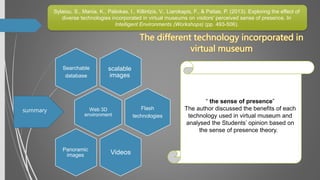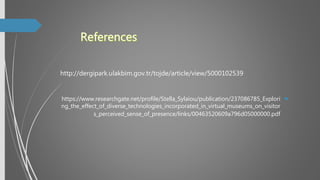قراءات في التربية باللغة الإنجليزية
- 1. Readings on Education in English Abdulaziz Al-Harbi 1601661 Dr. Abdulallah Al-sulaimani Supervisor:Done by: Ministry of Education King Abdulaziz University Graduate Education Department of Education Technology Virtual museum
- 2. Virtual museum Background Examples of technologies used in virtual museum Using virtual museum application in open education objectives implicationProblems History Definition scalable images Web 3D panoramic images Videos searchable database Flash technologies History classes Pros & cons
- 3. Ulusoy, K. (2010). Open Education Students’ Perspectives On Using Virtual Museums Application In Teaching History Subjects. Turkish Online Journal of Distance Education, 11(4). The author described what is the virtual museum and discussed the effect of using virtual museum in the open education students altitude towards history classes Virtual museums: Are websites that contain collections of digitized artefacts and information resources. They can contain text, photos, movies, audio files, maps, graphs, and links to other sites in the Internet. Objectives: It can Provide virtual restorations and reconstructions of paintings and sites. Bring together objects in a fictive space. It can be applied in the schools and universities to show students objects that can not be available to schools and to add a technological way in teaching different subjects such as science and history. summary
- 4. Ulusoy, K. (2010). Open Education Students’ Perspectives On Using Virtual Museums Application In Teaching History Subjects. Turkish Online Journal of Distance Education, 11(4). Using virtual museum in the open education has a good effect on student learning process Develop the students’ knowledge, improve the teaching method, give a clear description about the objects. Improve the students’ computer skills. Provide a motivated learning environment. Could contains unlimited number of objects. Reflection
- 5. Sylaiou, S., Mania, K., Paliokas, I., Killintzis, V., Liarokapis, F., & Patias, P. (2013). Exploring the effect of diverse technologies incorporated in virtual museums on visitors' perceived sense of presence. In Intelligent Environments (Workshops) (pp. 493-506). summary scalable images Searchable database Web 3D environment Flash technologies VideosPanoramic images “ the sense of presence” The author discussed the benefits of each technology used in virtual museum and analysed the Students’ opinion based on the sense of presence theory.
- 6. Refelction The aim of a Virtual Environment (VE) is the ability to mislead one’s senses so well that the illusion of being in the real-world situation simulated is created. virtual museum which uses Web3D technology offers a real-time navigation in three dimensional space has evoked a high level of perceived presence






